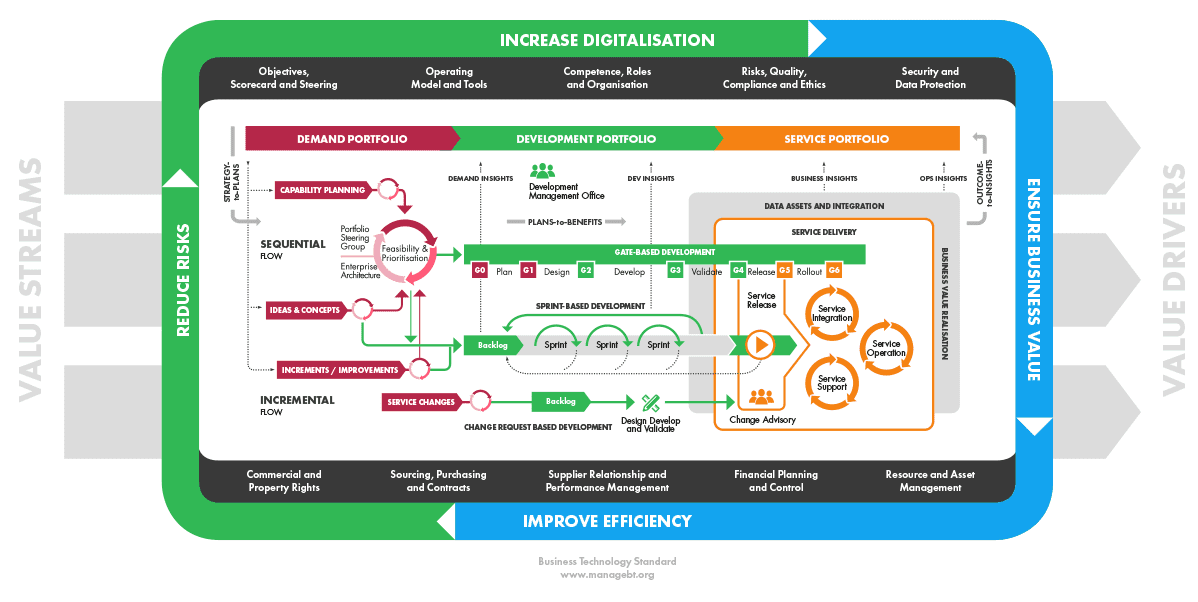Service support responds to day-to-day questions from users, handles service requests and resolves incidents. The range of users served by the service support can include customers and external partners as well as internal employees.
Support and service request volumes are usually very high and variable. For example, service support has to be able to solve and respond to both specific service requests, such as give instruction for using a specific service and routine tasks like resetting a password.
To be able to handle the variety of service requests and solve incidents, service support is organised into tiers where each tier has a different purpose and way of working. The two topmost tiers, self-service (tier 0) and service desk (tier 1), interact directly with users and operate usually 24/7. Service desk agents are trained and instructed to support users in all service-related questions. Requests that cannot be resolved by the service desk are assigned to service delivery organisations or key users (tier 2). Cases requiring in-depth technical knowledge are assigned to development teams or technology providers (tier 3).
Figure 6.4.1 Service support tiers
As illustrated in the picture above, support and service requests can be divided into four categories:
Self-service and self-help portals assist with predefined service requests and knowledge base articles to provide instant service to users 24/7 and to resolve the FAQs. The use of self-service and self-help together with workflow automation makes the support independent of time and place, thus increasing the user satisfaction and, at the same time, lowering the operational costs. Self-service portal has become today the most important support channel and, in fact, the only reason to name it as tier 0 is to keep the traditional convention to refer to the service desk as tier 1.
The term ‘portal’ is somewhat misleading as, nowadays, the self-service is like any organisation’s web page with fill-in forms and search functionalities. The only difference is the use of the service management system providing service catalogue, workflows for service requests and detailed service information as the logic behind the portal.
In order to gain high self-service portal usage levels, the focus during development must be put on enhancing the user experience. Excellent end-to-end user experience can be achieved by utilising personalised content, user-intuitive language, icons and terminology and promoting the relevant information. For example, customers and users should only see the services available to them and be able to create requests without understanding the service delivery organisation’s structure or processes. In addition, important information like need for an approval should be highlighted when the order is in the approval stage.
Figure 6.4.2 Example of self-service portal
Organisations are constantly seeking new ways to increase user satisfaction and lower operational costs. One way to do this is to automate the support routines by establishing an artificial intelligence (AI) powered digital worker to extend the human service desk (tier 1).
Figure 6.4.3 Digital service desk
Figure 6.4.3 shows the use of a digital worker in a service desk. The digital worker interacts with the user in natural language and initiates the service routines based on the dialogue. The advantage of a digital worker is its capability to learn from use cases and provide the highest-level service to everyone independently of time and place differences.
In the scenario illustrated above, the need for a traditional service desk is cut in half assuming that the digital worker can understand 90% of the user requests and is able to automate 60% of the required actions. This lowers the cost and changes the role of a human-operated service desk which, by consequence, has to deal less with routine work and can take care of more advanced questions as well as give support to business changes. This way, the traditional service desk is transformed into a business support centre which is an ideal way to support business excellence and transformation in any company.
